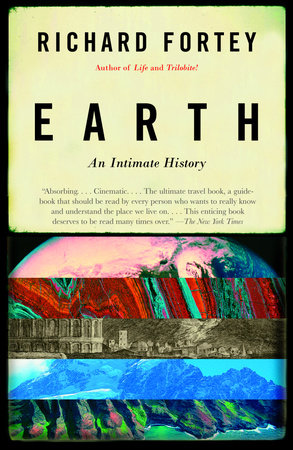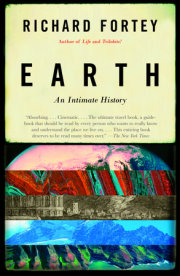Chapter 1
Up and Down
It should be difficult to lose a mountain, but it happens all the time around the Bay of Naples. Mount Vesuvius slips in and out of view, sometimes looming, at other times barely visible above the lemon groves. In parts of Naples, all you see are lines of washing draped from the balconies of peeling tenements or hastily constructed apartment blocks: the mountain has apparently vanished. You can understand how it might be possible to live life in that city only half aware of the volcano on whose slopes your home is constructed, and whose whim might control your continued existence.
As you drive eastwards from the centre of the city, the packed streets give way to a chaotic patchwork of anonymous buildings, small factories, and ugly housing on three or four floors. The road traffic is relentless. Yet between the buildings there are tended fields and shaded greenhouses. In early March the almonds are in flower, delicately pink, and there are washes of bright daffodils beneath the orchard trees; you can see women gathering them for market. In the greenhouses exotic flowers such as canna lilies can be glimpsed, or ranks of potted plants destined for the supermarket trade. Oranges and lemons are everywhere. Even the meanest corner will have one or two citrus trees, fenced in and padlocked against thieves. The lemons hang down heavily, as if they were too great a burden for the thin twigs that carry them. The soil is marvellously rich: with enough water, crops would grow and grow.
This was an abundant garden in Roman times, and it still is, even if crammed between scruffy apartments and scrap-metal yards. Volcanic soil is rich in minerals; it is correspondingly generous to crops. Outside the city, Vesuvius is more of a continuous presence; the ground rises gently towards its brown summit. New buildings cling on to the side of the mountain, even high up among the low trees and broom bushes that clothe its flanks. The buildings are indistinct, however, hidden by a creamy-yellow haze of petrochemical smog spreading outwards from the frantic centre of Naples towards the mountainside. You pass a road sign to Pompeii, but from the road there is little to distinguish this suburb from any other, for all its fame.
When the road rises into the hills that abut the southern margin of the Bay of Naples, the urban sprawl begins to thin out. The orange groves are more orderly, with the trees neatly planted in rows inside cages made of makeshift wooden struts, draped over the top with nets. The slopes become much steeper than on the volcanic flanks—close terraces piled one upon the other, each banked up with a wall of pale limestone blocks. Medium-sized trees with small grey-green leaves—which appear almost silvery in the afternoon light—cling to the most precipitous terraces. These are olive trees, the definitive Mediterranean survivors, oil producers and suppliers of piquant fruit. Their deep roots can seek out the narrowest cracks. They relish limestone soils, however poor they are in comparison with volcanic loam. The villages in this part of the bay are as you would expect of regular, tourist Italy, with piazzas and ristorante-pizzerias and youths with slick hairstyles on the lookout for a fast buck. Even this long before the summer season there is opportunity for a smooth operator. You find yourself agreeing to hire a cab for a day for ¬200 to hug the congested roads, when you could travel faster on the excellent Circumvesuviana railway for a tiny fraction of the price. Somehow, you, the visitor, have become the rich volcanic soil primed to yield a good harvest.
Near the tip of the southern peninsula, Sorrento commands a wonderful prospect of Mount Vesuvius across the entire Bay of Naples. From this steep-sided town, Vesuvius looks almost the perfect, gentle-sided cone. It could be a domestic version of Mount Fuji, the revered volcanic mountain in Japan. It can appear blue, or grey, or occasionally stand revealed in its true brown colours. On clear days Vesuvius is starkly outlined against a bright sky: a dark, heavy, almost oppressive presence. Or on a misty morning its conical summit can rise above a mere sketch or impression of the lower slopes, which are obscured in vapour, as if it were cut off from the world to make a house for the gods alone. At night, ranks of lights along Neapolitan roads twinkle incessantly. Vesuvius is often no more than a dark shape against a paler, but still Prussian blue sky. The lights might persuade you that the mountain was still in the process of eruption, with points of white illumination tracking lava flows running down the hillsides. From Sorrento, you can make of Vesuvius what you will, for within a day it will have remade itself.
The Bay of Naples is where the science of geology started. The description of the eruption of Vesuvius and the destruction of Pompeii in a.d. 79 by Pliny the Younger is probably the first clear and objective description of a geological phenomenon. No dragons were invoked, no clashes between the Titans and the gods. Pliny provided observation, not speculation.
Not quite two millennia later, in 1830, Charles Lyell was to use an illustration of columns from the so-called Temple of Serapis at Pozzuoli, north of Naples, as the frontispiece to volume 1 of the most seminal work in geology—his Principles of Geology. This book influenced the young Charles Darwin more than any other source in his formulation of evolutionary theory: so you could say that the Bay of Naples had its part to play, too, in the most important biological revolution. Everybody who was anybody in the eighteenth and nineteenth centuries visited the bay, and marvelled at its natural and archaeological phenomena. For geology—a latecomer to the pantheon of sciences—the area is the nearest thing to holy ground that there is. If you were going to choose anywhere to retrace the growth in our understanding about how the earth is constructed, what better place to begin? Where else more appropriate to explain first principles? The long intellectual journey that eventually led to plate tectonics started in this bite out of the western shin of Italy’s boot-shaped profile. A voyage around this particular bay is a pilgrimage to the foundations of comprehension about our planet.
Everything about Sorrento is rooted in the geology. The town itself is in a broad valley surrounded by limestone ranges, which flash white bluffs on the hillsides and reach the sea in nearly vertical cliffs—an incitement to dizziness for those brave enough to look straight down from the top. Seen from a distance, the roads that wind up the sides of the hills look like folded tagliatelle. Stacked blocks of the same limestone are used in the walls that underpin the terraces supporting the olive groves. In special places there are springs that spurt out fresh, cool water from underground caverns. These sources are often flanked by niches containing the statue of a saint, or of the Virgin: water is not taken for granted in these parts. There are deep ravines through the limestone hills, probably marking where caves have collapsed. The country backing the Bay of Naples is known as Campania, and the same name, Campanian, is applied to a subdivision of geological time belonging to the Cretaceous period. If you look carefully on some of the weathered surfaces of the limestones, you will see the remains of seashells that were alive in the age of the dinosaurs. I saw some obvious clams and sea urchins, belonging to extinct species, emerging from the cliffs as if they were on a bas-relief. A palaeontologist can identify the individual fossil species, and use them to calibrate the age of the rocks, since the succession of species is a measure of geological time. The implication is clear enough: in Cretaceous times all these hilly regions were beneath a shallow, warm sea. Limy muds accumulated there as sediments, and entombed the remains of the animals living on the sea floor. Time and burial hardened the muds into the tough limestones we see today. They are sedimentary rocks, subsequently uplifted to become land; earth movements then tilted them—but this is to anticipate. What one can say is that the character of the limestone hills is a product of an ancient sea.
The massive limestones continue westwards on to the island of Capri, which is a twenty-minute ferry ride from Sorrento and bounds the southern edge of the Bay of Naples. The island rises sheer from the sea, circumscribed by steep limestone cliffs, and your first thought is how could it support the smallest village, let alone a town. The town of Capri lies at the top of a vertiginous funicular railway running from the harbour. The buildings are ancient and quaint, and, naturally enough, built of the local stone. The blocks themselves are often concealed under stucco. There is a fine medieval charterhouse where the pale limestone is put to good effect in columns supporting cloisters. Almost everything else is fabricated of limestone—walls, floors, piazzas. In the bright Mediterranean light there is an overwhelming sense of whiteness; some of the villas glimpsed on the hillside have the appearance of frosted cakes tucked under umbrella pines. Only dark basalt must have been imported from Vesuvius to make the surfaces of the streets: this volcanic rock is less liable to shatter than limestone. It is not difficult to imagine the racket that iron-rimmed wheels made as they clattered over these roughly matched, large blocks. On the inner side of the island there are truly astonishing vertical limestone cliffs dropping hundreds of metres to the sea. The Roman Emperor Tiberius spent his declining years in a palace on the island, the ruins of which endure. According to the prurient accounts of his chronicler Suetonius, he indulged every kind of sexual perversion in a life of epicene self-gratification. Small boys were favoured. Those who displeased him were liable to be thrown off the monstrous cliffs. There is a subtle undercurrent in the Caprese atmosphere that hints at such darker things. Just offshore there are two enormous and forbidding sea-stacks—masses of limestone isolated from the main cliff by the relentless erosion of the sea. According to Norman Douglas, this was the abode of the Sirens, whose alluring and fatal song Odysseus was able to resist only by being strapped to the mast of his vessel, while his muffled crew rowed onwards to safety. Capri makes you wonder whether an idyllic hilltop haven might eventually also deprave and destroy. One of the grandest villas (now a hotel) overlooking the fearsome cliffs was built by the Krupps dynasty, once the armourers of German ambitions. Unexpectedly, the builder apparently immersed himself in studying the growth of lampreys, a primitive and parasitic fish. On this island there is a seamless continuity with the past—with Hellenic myth and Roman decadence and medieval devotion. The island gardens have seen the ages come and go, perched high upon the hardened sediments of a sea far more ancient than human frailty.
There is something different about the cliffs behind the harbour in the middle of Sorrento. From afar they have a greyish cast, a dull uniformity, lacking all the brilliance of limestone. The streets career downwards towards the sea below the central piazza, following a steep-sided valley. Now you can see the rock in the valley sides. It is brownish, like spiced cake, and displays little obvious structure. Look closely and you see that embedded within it, like dates in a home-bake, there are darker patches. Some are little more than wisps, others are larger—angular pieces of another rock, here nearly black, there umber brown, some including little bubbles. Then you notice that the same rock has been recruited by the local builders to construct the high walls that line the steeply sloping path, comprising blocks a few tens of centimetres across, neatly cut and used like bricks. Clearly, this rock is softer than the rough limestones that bolster the hilly vineyards and terraces. Then you notice that the same stone has been used to construct the older buildings. Down by the port there are shops and cafés painted jolly ochre and sienna, but where the stucco has peeled— or where warehouses have simply been left undecorated—the same rock is revealed as having been used for their construction. Much of the town has grown from the identical rock that forms the steep cliffs backing the harbour.
This rock is called the Campanian Ignimbrite. Its origin was a catastrophe that happened 35,000 years ago: a gigantic volcanic explosion threw out at least 100 cubic kilometres of pumice and ash. The evidence still covers an area of more than 30,000 square kilometres around the Bay of Naples, extending from Roccamonfina in the north to Salerno in the south. The violence of this eruption would make the event that buried Pompeii seem like a small afterthought. An explosion of steam and gluey lava blew out a great hole in the earth at the edge of the Tyrrhenian Sea—not so much a bite out of Italy’s profile as a huge punch. A vast cloud of incandescent material buoyed up with gas flowed like a fiery tidal wave across the limestone terrain. Lumps of volcanic rock were carried along willy-nilly in the mayhem: destruction of vegetation was complete. When the cloud settled, in many places it was hot enough to fuse solid: the wispy remains of volcanic fragments testify to this welding.* There were almost certainly Palaeolithic human witnesses to this destruction, who must have thought the gods had gone berserk. The legacy of the earth’s ferocity is this apparently mundane rock that looks like cake. The angular fragments of rock within can now be seen for what they are—pieces of a destroyed volcano. It is ironic that this destruction has now been reversed into constructing buildings that are “safe as houses.” Naturally, nothing is safe in this uncertain world. Looking down from the limestone hills you can imagine the hot, devastating clouds settling over where limoncello is now brewed and pizzas are spun, dumping down on the low ground as a thick, lethal blanket. These kinds of rocks were deposited from pyroclastic surges. Another eruption about 23,000 years later was marginally less devastating and did not spread so widely—it produced a different deposit known as the Tufo Galliano Napoletano, the Neapolitan yellow tuff. Rather than the colour of cake, it is the colour of Dijon mustard. Once you can recognize it, you spot blocks of it in many walls and buildings around Naples itself—it is almost reminiscent of the “London stock” bricks that make the Georgian parts of the English capital so appealing. It is there in the walls of Roman remains. Most experts believe that the volcanoes that remain to this day in the Campi Flegrei are aligned around the edge of the massive hole, or caldera, left behind as the legacy of this second huge eruption. The Bay of Naples itself hides most of it. It may yet blow again.
Copyright © 2005 by Richard Fortey. All rights reserved. No part of this excerpt may be reproduced or reprinted without permission in writing from the publisher.












